Wenshu Temple Grottoes Group
Wenshu Mountain Grottoes is one of the existing grottoes with a long history, located in the Qifeng Tibetan Township of Sunan County, Zhangye City. It is a nationally significant cultural relic protection unit with a history of about 1,500 years. It is a national 4A-level tourist attraction. The existing grottoes in the scenic area are the remains of early Chinese Buddhism. The Wenshu Grottoes have the same layout characteristics as early cave murals found in the Hexi region. These grottoes are a valuable resource for studying Buddhist art during the Sixteen Kingdoms period. They can be compared to the murals found in the Mogao Grottoes and are known as the “Little West Heaven” of the western grottoes. Wenshu Mountain Grottoes are a significant part of the Hexi corridor grottoes and treasure mural art. They are located west of Changma Grottoes, Mogao Grottoes, and Yulin Grottoes, and east of Matis Temple and Tiantishan Grottoes.
The Wenshu Temple grottoes are divided into two sections: the Front mountain and the Back mountain. They serve as sites for religious practices for different faiths like Tibetan, Chinese Buddhism, and Taoism. It consists of seven parts, including Manjusri Temple, Baizi Building, Puhua Temple, Thousand Buddha Cave, Ten Thousand Buddha Pagoda, Five Hundred Arhats Hall, and Guanyin Cave. There are more than 30 grottoes in Wenshu Mountain, more than 500 Buddha statues, and more than 1,200 square meters of murals. The Front Mountain area is the remains of early Chinese Buddhism, mainly famous for the mural paintings collected in the Thousand Buddha Cave and Ten Thousand Buddha Cave. The Back Mountain Grottoes are a place where Buddhism and Taoism coexist and are famous for the Five Hundred Arhats Hall.
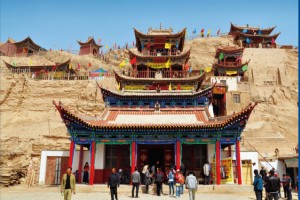
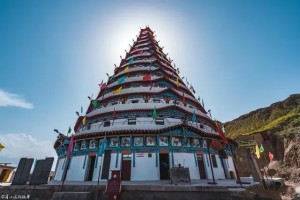
Information
Chinese Name: 文殊寺石窟群
Location: Qifeng Tibetan Township of Sunan County, Zhangye City.
Existing time: 1500
Ticket Price: 42 yuan/person
Opening Time: Peak Season 08:00—18:00 Off Season 08:00—17:30
Traffic profile: 26 km from Jiayuguan City
25 km from Jiuquan City
60 km from Yumen City
200 km from Zhangye City
400 km from Dunhuang City
500 km from Subei County.
Self-driving route: Zhangye City -G30-G227-S213-G30- Suzhou Road - Jiefang Road - Scenic spot
Lanzhou City -G312-G312(old)-G30- Zhangye - Suzhou Road - Jiefang Road - Scenic spot
Maiji Mountain, a national 5A tourist attraction in China, boasts a history of over 1,600 years and is one of the country's four major grottoes. It is located in Maiji District, Tianshui City. During the Later Qin period of the Sixteen States, from 384 to 417, the Mogao Caves were built. They consist of 221 caves, 10,632 clay and stone sculptures, and more than 1,300 square meters of murals. The caves are mostly small and scattered but contain a large number of world-famous wood and clay sculptures. Maijishan grottoes are dominated by clay sculptures, which are mainly presented in the form of religion, art, and architecture, reflecting the characteristics of clay sculptures at various times and reflecting the development and evolution of Chinese clay art in the past thousand years. Maiji Mountain has the reputation as “Oriental Sculpture Exhibition Hall”.
The Maijishan Grottoes, located at a pivotal point on the Silk Road, were influenced not only by the Western regions but also by the cultures of the Central Plains and Southern areas. This convergence resulted in a unique artistic style of sculpture and murals that can be found nowhere else. The Maijishan Grottoes are a true treasure trove of Buddhist art. The murals and Buddha statues in Maiji Mountain showcase the religious, cultural, and social aspects of various historical periods, which have played a significant role in the evolution of traditional Chinese Buddhist art. Aside from, its high value in Buddhist art, Maiji Mountain has also profoundly influenced stone carving, sculpture, painting, and other related aspects.
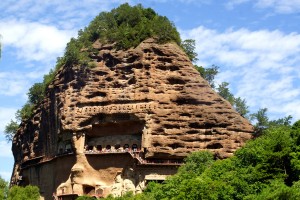
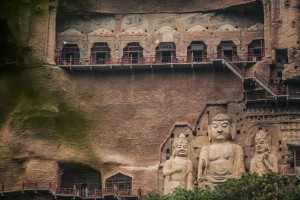
Information
Chinese Name: 麦积山石窟
Location: Maiji District, Tianshui City
Existing time: 1600
Ticket Price: 80yuan/person
Opening Time: 04/01-10/31 08:30-17:30; 11/01-03/31 09:00-17:00
Traffic route:
Route 1: Tianshui Railway Station No. 34 bus direct,
Route 2: Tianshui Old Street, Fuxi Temple has a free bus, you can direct
Route 3: Tianshui high-speed Railway station direct bus, can direct.
Self-driving route: Tianshui -G310-X633- Maiji Mountain
There are many temples along the Northwest, on the millennium Silk Road, Zhangye is an indispensable stop to come to Zhangye in addition to see Danxia, if you also want to feel the local culture and look at the natural scenery - Matis Temple. Matis Temple is a cave on the cliff, and a cave on the top of the mountain has left deep footprints of horses' hooves, so it is known. Matis Temple is a national 4A-level scenic spot, and the grottoes of Matis Temple belong to the national key cultural relics protection units. It has a history of 1600 years.
Matis Temple, located on the Hexi Corridor, was initially a Chinese Buddhist shrine that later transformed into a Tibetan Buddhist temple. Matis Temple grottoes consist of seven small grotto groups, including the Thousand Buddha Cave, North and South Horseshoe Temple, Upper, Middle, and Lower Guanyin Cave, and Jinta Temple. Each grotto group has more than 30 grottoes and less than two grottoes, totaling more than 70 grottoes. The Thirty-three Day Grottoes are the tallest and most famous building in the Horseshoe Temple, with a height of five stories. In terms of statues and murals, Jinta Temple and thousand Buddha Cave are of great significance. The Matis Temple scenic spot has become the best place for domestic and foreign tourists to enjoy the art of the grottoes, experience the customs of Yugu, and visit the scenery of Qilian.
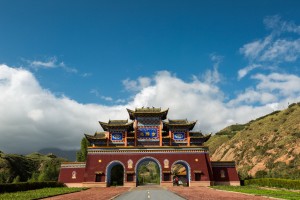
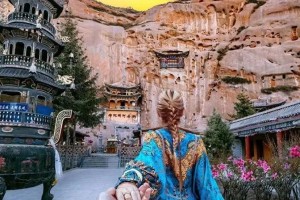
Information
Chinese Name: 马蹄寺石窟
Location: Sunan Yugur autonomous county, Zhangye City, horseshoe Tibetan Village
Existing time:
Ticket Price: 75yuan/ person
Opening Time: 8:30-18:00;
Show time: 11:00-11:45 am, 3:30-16:15 PM
Traffic route: In Zhangye city, you can take the tour bus to the horseshoe Temple at the South Bus station
At Xiguan Station or South Bus Station in Zhangye City, take the fixed shuttle bus to the Horseshoe Temple Scenic spot.
Tiantishan Grottoes
If you want to learn about Chinese grotto culture, Tiantishan Grottoes are the first choice. Tiantishan Grottoes, located in Wuwei City, Gansu Province, is one of the representatives of early grottoes art in China and the ancestor of Chinese grottoes. The Tiantishan Grottoes is a cultural and artistic attraction that one should not miss when visiting Wuwei. It was first carved out during the Northern Liang period of the Sixteen States in the Eastern Jin Dynasty and has a history of over 1600 years. Currently, only 13 caves are open to the public in Tiantishan Grottoes, with the largest cave being the most popular among visitors.
The extant Tiantishan grottoes are not complete. To solve the land irrigation problem, the government had to build a reservoir near the Tiantishan Grottoes. To prevent the precious cultural relics of the grottoes from being submerged, part of the cultural relics in the Tiantishan Grottoes were relocated and protected, and most of the cultural relics such as Buddha statues and murals were transported to the Gansu Provincial Museum. One of the most well-known statues is the 28-meter-tall Shakyamuni from the Tang Dynasty. The statue is flanked by six other statues - Kasye, Ananda, Puxian, Manjusri, Guangmu, and Tianwang. The statues are realistic, each with a unique image and exquisite shape. The cave's north and south walls are adorned with large murals, which had a tremendous influence on other grottoes.
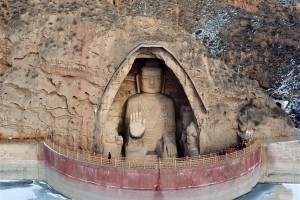
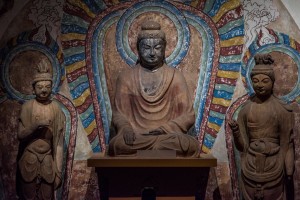
Information
Chinese: Tiantishan Grottoes
Location: Wuwei City Liangzhou District Zhangyi town Dengshan village
Existing time: 1600
Ticket Price: Full ticket: 30 yuan Half ticket: 15 yuan
Opening Time: Peak season May 1 - October 31)
Opening hours (8:30-18:00, tickets closed at 17:30)
Off-season (November 1 - April 30)
Opening hours (9:00-17:30, tickets closed at 17:00)
Service Number: 0935-2980219
Bingling Temple Grottoes
The Bingling Temple grottoes are the oldest Buddhist grottoes known to date. The Grotto was constructed in 420 AD and currently contains 183 caves, 694 stone statues, 82 clay sculptures, and approximately 900 square meters of murals. These works of art are spread out along the Yellow River, 200 meters away from the rock wall. There are the earliest, middle and late murals and stone carvings of domestic grottoes preserved here, which is known as "the encyclopedia of Chinese grottoes".
The Bingling Temple Grottoes are the first Yellow River grottoes on the Silk Road. The Yellow River passes through the Bingling Temple Grottoes, and the two sides of the bridge are connected by a bridge, which is named "the first bridge under heaven". The famous Silk Road, the Ancient Road of the Tang Dynasty, and the Ancient Road of Tea Horse all pass through this bridge and then extend forward respectively. Therefore, in 2014, Bingling Temple Grottoes was successfully included in the World Cultural Heritage list as a site in the "Silk Road: Network of Changan-Tianshan Corridor" jointly applied by China, Kazakhstan, and Kyrgyzstan.
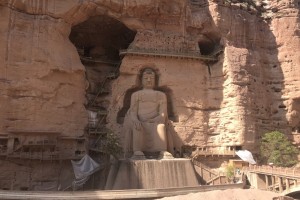
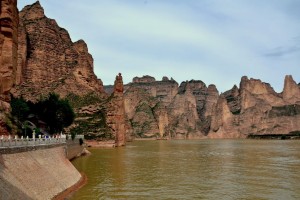
Information
Chinese: 炳灵寺石窟
Location: 35 km south of Yongjing County, Hui Autonomous Prefecture, Linxia
Existing Time: 1600
Ticket Price: The general ticket is 100 yuan (including grottoes and Bingling Danxia), and the special grottoes (Grottoes 169 and 172) are 300 yuan
By boat: (speedboat 160/ person; Small boat 140/ person).
Opening Time: 9:00-17:30
Speedboat: April - October 08:00-16:00 November - March 08:30-15:00
Service Number: 0930-6912105




































